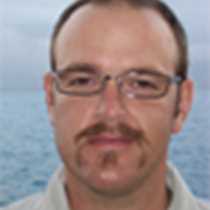Isabela
What a wondrous day as we awoke to a blood red sun rising over Isabela Island. Arriving at the coast of Isabela and Alcedo volcano we all noticed that there were large breaking waves far offshore. Due to an uplift of the coastal area in 1954, the sea floor has drastically changed and the underwater bathymetry along with it. Coral heads, crustaceans and an abundance of invertebrates were trapped high and dry within a very short period by the uplifting.
We landed on shore and made our way around and through this uplifted area observing the dramatic change that took place. Land iguanas greeted us with a lethargic nod as they sunned themselves along the trail. There is a dramatic difference between these iguanas and the coastal marine iguanas, not only morphologically but also in their behavior. We noticed a large burrow along the path that was dug by a male in anticipation of a passing female. The native and endemic vegetation surrounded us with carpenter bees and butterflies doing their part in the pollination of these unique plants. As we started our hike back to our landing beach, we encountered a young giant tortoise that was trying to find shade to cool its sunbaked carapace. Upon our return to the beach we found a recently hatched Pacific green sea turtle making its way to the waterline — at last it has survived this first test with no land predator in sight.
Tagus Cove north of Urbina Bay shows us that human behavior leaves a mark in the environment. Graffiti dating back to the early eighteen hundreds offers a history lesson of past visitors to this site. As soon as we arrived we disembarked the ship to explore. Kayaking along the coast reveals penguins, flightless cormorants, and pelicans trying to gain their daily sustenance. As the snorkelers departed they were apprehensive about the water temperature of 71 degrees. We encountered penguins feeding, turtles resting in the shallows and a Galápagos bullhead shark, quite an incredible species discovery.
Climbing to the top of Tagus Cove gave us an idea of Charles Darwin’s view when he visited this site in 1835. The sun dropped on the horizon as fast as it came to us this morning, but now we understand a bit more about this delicate, beautiful world




